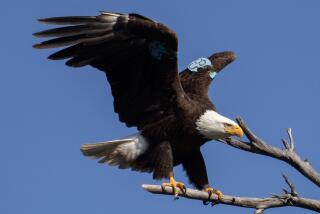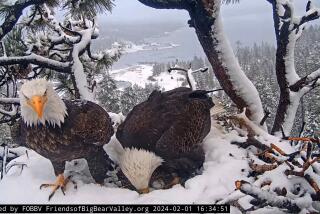Bald Eagles Making a Dramatic Comeback From DDT’s Damage : Nature: The living emblem of the United States can be found in all of the lower 48 states at one time or another--nesting, migrating or hunting.
GENEVA, Pa. — During the last ice age about 16,000 years ago, when mammoths and mastodons roamed Pennsylvania, the boulders and gravel from retreating glaciers filled an ancient stream channel and created a 13-mile-long expanse of water, waterlilies and waterfowl.
From all appearances, little has changed. Conneaut Marsh is inaccessible except by canoe, and even then channels must be cut periodically through the mucky sediments and viney undergrowth to allow even limited passage.
It is in this isolated setting, flanked on all sides by sparsely populated farms and tall stands of trees, that a pair of bald eagles have built a home.
They represent two of 10 bald eagles nesting in water-rich Crawford County in northwestern Pennsylvania. Another 10 are believed to have taken up permanent residence along rivers in the central part of the state, thanks to programs devoted to relocating chicks taken from Canadian nests and reintroducing them to the state.
“This is an effort to return the national emblem to Pennsylvania and make it available for citizens to observe without having to go to Alaska or Canada,” said Jack Byerly of the state Game Commission.
“When I see an eagle flying along the river I want to say to my kid: ‘There goes our national emblem.’ I don’t want to say: ‘There goes one released from the Hershey Zoo.’ I want to see it wild and flying free.”
Throughout the country, from the deserts of Arizona to the swamps of Florida to the deep waters of the Chesapeake Bay, eagles have made a dramatic comeback from the days of the now-banned pesticide DDT, which decimated the species three decades ago.
The population has climbed from an all-time low of about 350 nesting pairs in the mid-1960s to about 2,400 nesting pairs today, according to the National Audubon Society.
An additional 3,000 to 7,000 younger birds--under the breeding age of 5 years--are believed to roam the skies, including roughly 800 that have been released through relocation programs over the last decade.
Although 20 eagles seems a small number in a state as large as Pennsylvania, there are countless more eagles spotted throughout the state at various times of year, Byerly said.
Many are simply passing through on their migratory routes, while others are part of a group of 88 young eagles that have been released over the last seven years but are not old enough to mate and build nests.
Able to adapt to subarctic temperatures and hot, arid climates, the bald eagle is most often found where there is water and lots of fish.
“This bird can literally be found in all the lower 48 states at all times of the year, either as a nesting bird, a migrating bird or a wintering bird,” said Dan James, an endangered species biologist with the U.S. Fish and Wildlife Service in Minneapolis. “It nests in all but perhaps three or four states and it winters in or migrates through the rest.”
So successful has been their recovery that the Fish and Wildlife Service is considering taking eagles off the list of endangered species and changing their classification to threatened, James said.
“Legally, a threatened species is one that may become endangered if trends in the population continue,” he said. “What we’re seeing, though, is just the opposite. Clearly, the eagle is on the increase.”
But conservation groups say the tough, majestic bird is still too fragile, too easily harmed by man’s destructive ways, to take any chances. The Exxon Valdez oil spill in Alaska, for example, inflicted severe casualties in Alaska’s eagle-nesting grounds.
They say we are still a long way from the estimated 50,000 eagles that once soared above the United States when this country was young and the eagle was named the national symbol.
“There’s not a lot of room for error on this. A bird as big and vulnerable to habitat loss and poaching as the bald eagle deserves constant attention, and we would rather err on the side of caution,” said M. Rupert Cutler, president of Defenders of Wildlife.
“Although DDT is behind us, there are new chemicals being invented every day,” he said. “In addition, we see rapid population growth, urbanization, the loss of wetlands and the loss of old growth forest trees in which the eagles nest, and there’s no reason for optimism as far as eagle habitat protection is concerned.”
Jim Pissot, who specializes in endangered species for the National Audubon Society in Washington, said he is excited by the idea that eagles may have recovered sufficiently to warrant changing their status.
But, like Cutler, he worries their habitat will be whittled away little by little by a country eager to clear forests, drain wetlands and build roads.
“Without strong federal oversight, we could be picking away at their habitats--a nest tree there, some roosting areas someplace else--and we could be in the position we were in 40 years ago,” he said.
“Even with the bird listed as endangered, there still is the possibility that habitat will be lost. But as the bird is down-listed to ‘threatened,’ that door opens wider, and if it’s taken off the list entirely, that door opens very wide.”
Regardless of the federal government’s decision, Pennsylvania wildlife officials plan to maintain strict vigils over the state’s brood.
In Conneaut Marsh, for instance, birdwatchers are allowed no closer than a half-mile from the eagles’ nest, or aerie, while motorists driving through nearby Erie National Wildlife Refuge are not permitted to stop or park on a section of roadway near another nest.
“They are so fragile,” said Brenda Peebles, who monitors the 10 Crawford County eagles for the Pennsylvania Game Commission. “They don’t like people. They don’t like to be disturbed. If they have eggs and you come near them, they’re likely to abandon their eggs.”
A powerful predator, the bald eagle is happiest, ironically, when it doesn’t have to kill what it eats and can pick at the remains of dead fish and wounded ducks left behind by other predators.
“Eagles are thieves and robbers,” said Scott Wood, an ornithologist with the Carnegie Museum of Natural History in Pittsburgh. “The osprey will catch the fish and the eagles will steal it from them.”
Bob Faber, a free-lance naturalist from Hiram, Ohio, who conducts tours of Conneaut Marsh, chuckled. “It doesn’t make for a good image of the country,” he said.
Nevertheless, Americans are fascinated with the elusive, solitary bird.
A group of 40 Pittsburgh-area residents recently drove two hours and paddled canoes for several miles just to catch a glimpse--through binoculars--of the snowy white head of an eagle perched in a 7-foot-deep nest high atop a dead tree in Conneaut Marsh.
The marsh was alive with snipe, warblers, Canada geese, carp doing belly-flops. But it was the pair of eagles, either surveying their watery world from the nest or soaring silently over treetops, that captured everyone’s attention.
“I wouldn’t have missed this for the world,” said Betty Abernathy, 78, of Pittsburgh, who has traveled several continents to watch birds.
Gay Kalisz, 43, of McDonald, added: “It’s not like a walk in the woods. It was wonderful to see this after knowing of the slaughter they’ve gone through.”
More to Read
Sign up for Essential California
The most important California stories and recommendations in your inbox every morning.
You may occasionally receive promotional content from the Los Angeles Times.










